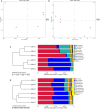Rumen Microbiota Distribution Analyzed by High-Throughput Sequencing After Oral Doxycycline Administration in Beef Cattle
- PMID: 32582771
- PMCID: PMC7280444
- DOI: 10.3389/fvets.2020.00251
Rumen Microbiota Distribution Analyzed by High-Throughput Sequencing After Oral Doxycycline Administration in Beef Cattle
Abstract
The beef cattle rumen is a heterogenous microbial ecosystem that is necessary for the host to digest food and support growth. The importance of the rumen microbiota (RM) is also widely recognized for its critical roles in metabolism and immunity. The level of health is indicated by a dynamic RM distribution. We performed high-throughput sequencing of the bacterial 16S rRNA gene to compare microbial populations between rumens in beef cattle with or without doxycycline treatment to assess dynamic microbiotic shifts following antibiotic administration. The results of the operational taxonomic unit analysis and alpha and beta diversity calculations showed that doxycycline-treated beef cattle had lower species richness and bacterial diversity than those without doxycycline. Bacteroidetes was the predominant phylum in rumen samples without doxycycline, while Proteobacteria was the governing phylum in the presence of doxycycline. On the family level, the top three predominant populations in group qlqlwy (not treated with doxycycline) were Prevotellaceae, Lachnospiraceae, and Ruminococcaceae, compared to Xanthomonadaceae, Prevotellaceae, and Rikenellaceae in group qlhlwy (treated with doxycycline). At the genus level, the top predominant population in group qlqlwy was unidentified_Prevotellaceae. However, in group qlhlwy, the top predominant population was Stenotrophomonas. The results revealed significant RM differences in beef cattle with or without doxycycline. Oral doxycycline may induce RM composition differences, and bacterial richness may also influence corresponding changes that could guide antibiotic use in adult ruminants. This study is the first to assess microbiota distribution in beef cattle rumen after doxycycline administration.
Keywords: MiSeq sequencing; bacterial richness; beef cattle; doxycycline; dysbacteriosis; oral antibiotics; rumen microbiota.
Copyright © 2020 Chen, Cheng, Xu, Wang, Xia and Hu.
Figures






Similar articles
-
Rumen Microbiome and Metabolome of High and Low Residual Feed Intake Angus Heifers.Front Vet Sci. 2022 Mar 25;9:812861. doi: 10.3389/fvets.2022.812861. eCollection 2022. Front Vet Sci. 2022. PMID: 35400092 Free PMC article.
-
Application of MinION Amplicon Sequencing to Buccal Swab Samples for Improving Resolution and Throughput of Rumen Microbiota Analysis.Front Microbiol. 2022 Mar 24;13:783058. doi: 10.3389/fmicb.2022.783058. eCollection 2022. Front Microbiol. 2022. PMID: 35401463 Free PMC article.
-
Bacterial communities in the solid, liquid, dorsal, and ventral epithelium fractions of yak (Bos grunniens) rumen.Microbiologyopen. 2020 Feb;9(2):e963. doi: 10.1002/mbo3.963. Epub 2019 Nov 7. Microbiologyopen. 2020. PMID: 31701637 Free PMC article.
-
Exploring the relationship between bacterial genera and lipid metabolism in bovine rumen.Animal. 2022 May;16(5):100520. doi: 10.1016/j.animal.2022.100520. Epub 2022 Apr 22. Animal. 2022. PMID: 35468508
-
Rumen fermentation, intramuscular fat fatty acid profiles and related rumen bacterial populations of Holstein bulls fed diets with different energy levels.Appl Microbiol Biotechnol. 2019 Jun;103(12):4931-4942. doi: 10.1007/s00253-019-09839-3. Epub 2019 Apr 24. Appl Microbiol Biotechnol. 2019. PMID: 31020378
Cited by
-
The Response of Ruminal Microbiota and Metabolites to Different Dietary Protein Levels in Tibetan Sheep on the Qinghai-Tibetan Plateau.Front Vet Sci. 2022 Jun 29;9:922817. doi: 10.3389/fvets.2022.922817. eCollection 2022. Front Vet Sci. 2022. PMID: 35847641 Free PMC article.
-
Bovine Animal Model for Studying the Maternal Microbiome, in utero Microbial Colonization and Their Role in Offspring Development and Fetal Programming.Front Microbiol. 2022 Feb 23;13:854453. doi: 10.3389/fmicb.2022.854453. eCollection 2022. Front Microbiol. 2022. PMID: 35283808 Free PMC article. Review.
-
Impact of systemic antimicrobial therapy on the faecal microbiome in symptomatic dairy cows.PLoS One. 2024 Jan 5;19(1):e0296290. doi: 10.1371/journal.pone.0296290. eCollection 2024. PLoS One. 2024. PMID: 38180967 Free PMC article.
-
Using PacBio SMRT Sequencing Technology and Metabolomics to Explore the Microbiota-Metabolome Interaction Related to Silage Fermentation of Woody Plant.Front Microbiol. 2022 Jun 20;13:857431. doi: 10.3389/fmicb.2022.857431. eCollection 2022. Front Microbiol. 2022. PMID: 35794909 Free PMC article.
-
Comparative Study of the Use of Doxycycline and Oxytetracycline to Treat Anaplasmosis in Fattening Lambs.Animals (Basel). 2022 Sep 2;12(17):2279. doi: 10.3390/ani12172279. Animals (Basel). 2022. PMID: 36077999 Free PMC article.
References
-
- Gruninger RJ, Puniya AK, Callaghan TM, Edwards JE, Youssef N, Dagar SS, et al. . Anaerobic fungi (phylum Neocallimastigomycota): advances in understanding their taxonomy, life cycle, ecology, role and biotechnological potential. FEMS Microbiol Ecol. (2014) 90:1–17. 10.1111/1574-6941.12383 - DOI - PubMed
LinkOut - more resources
Full Text Sources

